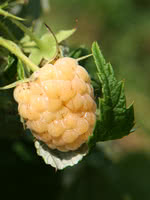Mon-Fri 9am - 5pm Mountain time
Honey Queen Raspberry vs Black Elderberry
Rubus x Honey Queen
Sambucus canadensis
NOT AVAILABLE THIS SEASON - MIGHT RETURN
Honey Queen Raspberry is known for its sweet honey flavor and unique yellow color. Its berries are soft and medium-sized, nice for picking and eating in the summer.
Honey Queen was developed in Rocky Mountain House by Robert Erskine and is very winter hardy. Canes are yellowish, floricane, arched and moderately spiny.
Honey Queen should be trellised upright for best results. While all raspberries prefer the sun, Honey Queen is the best option for planting in shady areas.
The Honey Queen Raspberry is a fast-growing floricane. This means that raspberries will not grow on canes the year they first grow. The mature canes they do grow on, however, produce more berries than primocane varieties.
Check out some video of a Honey Queen Raspberry we saw this summer on our YouTube Channel. Click here.
Black Elderberry is a deciduous shrub native to eastern North America. You can plant this shrub in moist areas and it will help stabilize your soil. You can also use it on rural properties anywhere you'd use a lilac.
Black Elderberries are considered to be partially self-pollinating. So while they will still produce some berries without cross-pollination, planting with another variety will increase yields. Consider planting with Ranch Elderberry or Bob Gordon Elderberry.
Warning: the seeds, stems, leaves, roots, and uncooked berries of the Black Elderberry are poisonous to humans when eaten in quantity. You should cook the berries to make them safe for human consumption.
Honey Queen Raspberry Quick Facts
Black Elderberry Quick Facts
Toxicity: leaves, stems, and uncooked berries are poisonous to humans

